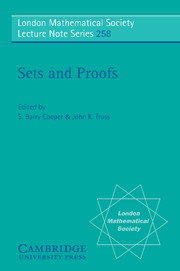Book contents
- Frontmatter
- Contents
- Preface
- An Introduction To Finitary Analyses Of Proof Figures
- What Mathematical Truth Could Not Be – II
- Proof Search in Constructive Logics
- David's Trick
- A Semantical Calculus for Intuitionistic Propositional Logic
- An Iteration Model Violating the Singular Cardinals Hypothesis
- An Introduction to Core Model Theory
- Games of Countable Length
- On the Complexity of the Propositional Calculus
- The Realm of Orinal Analysis
- Covering Properties of Core Models
- Ordinal Systems
- Polish Group Topologies
- Forcing Closed Unbounded Subsets of Nw+1
- First Steps into Metapredicativity in Explicit Mathematics
- What Makes A (Pointwise) Subrecursive Hierarchy Slow Growing?
- Minimality Arguments for Infinite Time Turing Degrees
What Mathematical Truth Could Not Be – II
Published online by Cambridge University Press: 05 September 2013
- Frontmatter
- Contents
- Preface
- An Introduction To Finitary Analyses Of Proof Figures
- What Mathematical Truth Could Not Be – II
- Proof Search in Constructive Logics
- David's Trick
- A Semantical Calculus for Intuitionistic Propositional Logic
- An Iteration Model Violating the Singular Cardinals Hypothesis
- An Introduction to Core Model Theory
- Games of Countable Length
- On the Complexity of the Propositional Calculus
- The Realm of Orinal Analysis
- Covering Properties of Core Models
- Ordinal Systems
- Polish Group Topologies
- Forcing Closed Unbounded Subsets of Nw+1
- First Steps into Metapredicativity in Explicit Mathematics
- What Makes A (Pointwise) Subrecursive Hierarchy Slow Growing?
- Minimality Arguments for Infinite Time Turing Degrees
Summary
“For now we see through a glass darkly, but then [we shall see] face-to-face.” Paul,
Corinthians I.13.12“When we look at a thing, we must examine its essence and treat its appearance merely as an usher at the threshold, we must grasp the essence of the thing; this is the only reliable and scientific method of analysis.”
Mao TseTung, “A Single Spark Can Start a Prairie Fire” January 5, 1930, Selected Works, Vol. I, p. 119“…By analysis we mean analyzing the contradiction in things. And sound analysis is impossible without a real understanding of the pertinent contradictions.”
Mao TseTung, Speech at the Chinese Communist Party's National Conference on Propaganda Work (March 12, 1957, 1st. pocket ed., p. 20)That is our task today then – to look at the thing, to examine its essence by treating its appearance as an usher at the threshold – by analyzing the pertinent contradictions. The glass through (in) which I would like us to look today is then (as in the quotation from Paul) a mirror offered by George Boolos's “Must We Believe in Set Theory?” – a wonderful, but, as I shall argue, unusually (even-for-George) enigmatic paper.
I will set the stage by reminding us very briefly of three accounts or conceptions of sets that figure in what I shall be discussing today – not so much for their specific details, but rather for the sake of broad-brush contrast. Nothing I say will depend on the exact detail.
- Type
- Chapter
- Information
- Sets and Proofs , pp. 27 - 52Publisher: Cambridge University PressPrint publication year: 1999

